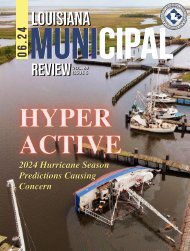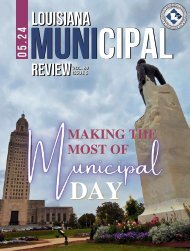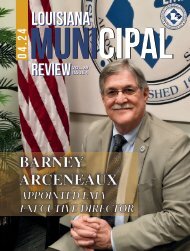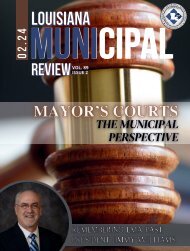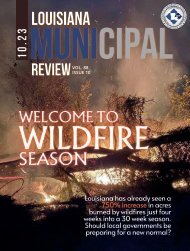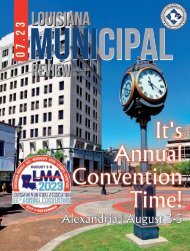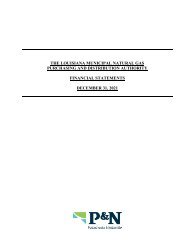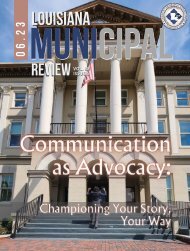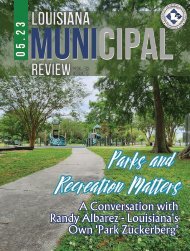GOHSEP Elected_Officials_Manual_2015
Create successful ePaper yourself
Turn your PDF publications into a flip-book with our unique Google optimized e-Paper software.
LSA-R.S. 29:721 – 739 Page 6<br />
(15) “Statewide communications interoperability plan for first responders” means a statewide<br />
shared communications system for first responders with the ability to transport and receive voice,<br />
data, image, and video information adopted by the interoperability subcommittee.<br />
(16) “Statewide interoperability plan” means short-term and long-term statewide plans for interoperability<br />
for communications and information sharing needed during an emergency and<br />
adopted by the state Unified Command Group.<br />
(17) “Terrorism” or “acts of terrorism” shall have the same meaning as provided in R.S. 14:128.1.<br />
CREDIT(S)<br />
Acts 1993, No. 800, § 1, eff. June 22, 1993. Amended by Acts 1998, 1st Ex.Sess., No. 57, § 1, eff.<br />
April 29, 1998; Acts 2001, 2nd Ex.Sess., No. 8, § 1, eff. Oct. 16, 2001; Acts 2003, No. 40, § 2, eff.<br />
May 23, 2003; Acts 2008, No. 214, § 1, eff. June 16, 2008; Acts 2008, No. 797, § 1; Acts 2009, No.<br />
512, § 1.<br />
§ 724. Powers of the governor<br />
A. The governor is responsible for meeting the dangers to the state and people presented by<br />
emergencies or disasters, and in order to effectuate the provisions of this Chapter, the governor<br />
may issue executive orders, proclamations, and regulations and amend or rescind them. Executive<br />
orders, proclamations, and regulations so issued shall have the force and effect of law.<br />
B. (1) A disaster or emergency, or both, shall be declared by executive order or proclamation of the<br />
governor if he finds that a disaster or emergency has occurred or the threat thereof is imminent.<br />
The state of disaster or emergency shall continue until the governor finds that the threat of danger<br />
has passed or the disaster or emergency has been dealt with to the extent that the emergency<br />
conditions no longer exist and terminates the state of disaster or emergency by executive order or<br />
proclamation, but no state of disaster or emergency may continue for longer than thirty days unless<br />
renewed by the governor.<br />
(2) The legislature, by petition signed by a majority of the surviving members of either house, may<br />
terminate a state of disaster or emergency at any time. This petition terminating the state of<br />
emergency or disaster may establish a period during which no other declaration of emergency or<br />
disaster may be issued. Thereupon, the governor shall issue an executive order or proclamation<br />
ending the state of disaster or emergency.<br />
© 2013 Thomson Reuters. No Claim to Orig. US Gov. Works.



